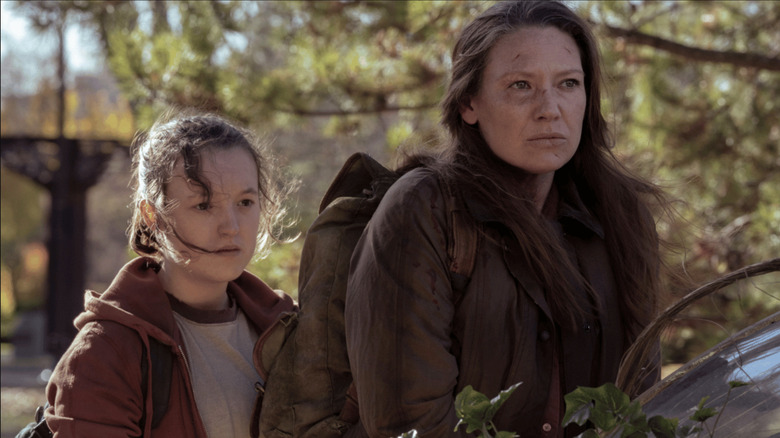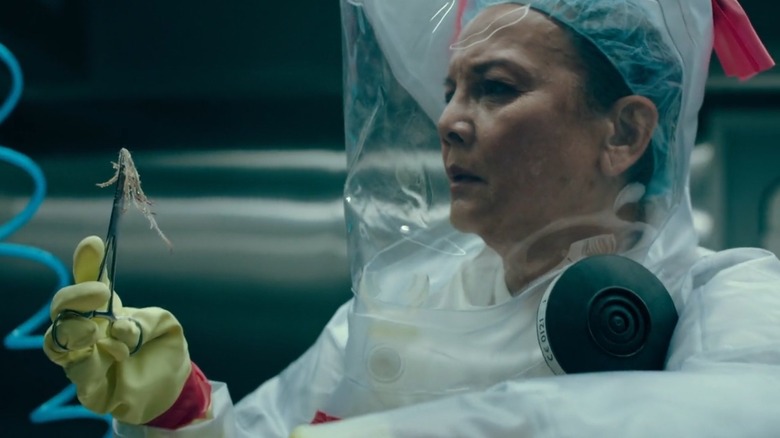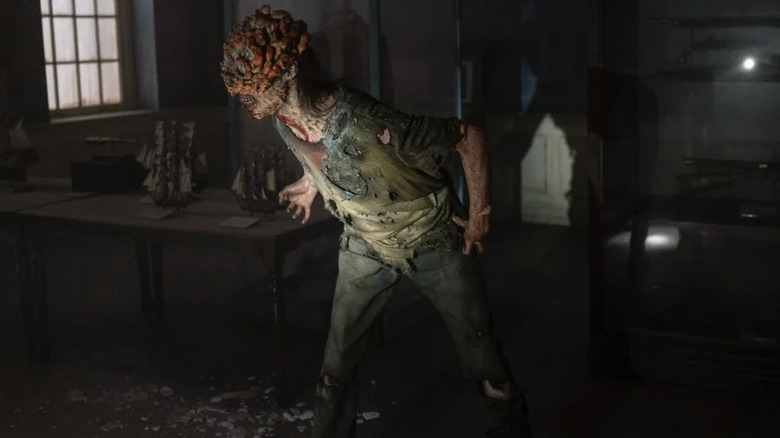How The Last Of Us Episode 2 Compares To The Original Video Game
"The Last of Us" continued this week with its intentional balancing of new and adapted elements from the game's story. While not a super eventful episode until the third act, significant departures from memorable aspects of the game revealed themselves this week. Joel, Ellie, and Tess made it to the Capitol in this episode in accordance with the original plot, but the details surrounding their arrival (and departure) from this chapter were altered to better fit the narrative intricacies of television. Episode 2, "Infected," was directed by Neil Druckmann, the co-creator of the HBO series and the original video game. But without gameplay to worry about, the series has more time to introduce exposition that didn't exist previously.
Discovering origins
Similar to the start of episode 1, we're given a flashback at the start of episode 2 that provides an exposition. We learn that the cordyceps brain infection (CBI) began at a grain factory in Jakarta, days before Joel's birthday in 2003. The implication of the virus starting at a grain factory is that the grains in question were to be made into flour, which would make it ubiquitous in food across the world. A scientist is snatched from her daily routine to examine the body of a person who was infected and executed because of a violent outburst. She initially did not believe what she was told by authorities, that the person was infected with a cordyceps virus (since, as we learned at the start of episode one, it was at one point impossible for the virus to survive in humans). But upon seeing living fungi inside the dead person's body, she went on to tell a military man that there was no hope of containing the outbreak.
The game never provided a full origin story for the infection; we're only told that the outbreak came from infected crops. When playing a video game, exposition is appreciated, but isn't necessarily the focus — gameplay is. You purchase a game to play it, and any story is a bonus. Gamers are more prepared to buy into whatever fantasy a game thrusts them into just to get to the gameplay.
But a TV show needs more fleshing out. TV audiences are more preoccupied with the "why" behind what they are seeing. There are no tangible elements (like gameplay) for the audience to cling to, so understanding why things are happening is the closest we can get to immersing ourselves in the story.
A new kind of clicker
Episode 2 also answers how exactly the CBI functions in humans and beyond.
The game's clickers were blind due to the infection overtaking the face, thus relying on sound to locate survivors. After natural death, the cordyceps fungi would continue to grow and eventually release spores. A person could become infected by inhaling spores, so whenever people encountered them in an area, they'd use gas masks to navigate through it.
In the show, the clickers are still blind and utilize echolocation, but they don't release spores. Instead, they seem to communicate via networks of tentacles (Tendrils? Mycelium?) above and below ground. Tess explains to Ellie that stepping on a branch of these fungal growths could awaken clickers from up to a mile away, alerting them to your location. I believe this change better serves TV. It will allow the characters to encounter infected in a less direct way, giving way to more chase scenes. It creates more suspense than simply walking into an area, encountering clickers, and watching Joel and Ellie shiv them one by one.
Infected can also communicate body-to-body via fungus in the series; this explains the strange "kiss" an infected gave to Tess before her death. The infected could likely sense the fungus within Tess, and used the tendrils coming from their own mouth to connect to the ones slithering within her. Say it with me — ew. The show's infected aren't mindless monsters as they are in the game — they are driven by something within.
Even with these changes, the series absolutely did justice to the aesthetic of the clickers. The look, sound, and movement of clickers are truly the game creatures brought to life. The producers stated that accuracy with the clickers was imperative to them, and they did not disappoint.
A surprising ending
Our protagonists venture through the same areas as the first chapter of the game in the same order. The scene where Ellie, Tess, and Joel leave the museum, as well as the Capitol scene, were true to the original versions. As the latter unfolded, I was blown away by how identical to the game it felt — until the end.
After Tess reveals that she's bitten, the group realizes the infected are rushing to the Capitol. Tess tells Ellie and Joel to escape while she stays behind to keep the infected from following them. Her plan was to pour gasoline on the floor and light a fire to torch the building and, after struggling with her lighter for a bit and being harassed by an infected person, she succeeds. The building explodes, and Joel and Ellie are on to their next destination. In contrast, the Capitol was being stormed by FEDRA agents in the game. We also never see Tess' death; once Joel and Ellie run out of frame, players linger with Tess for a moment before the screen cuts to black.
Switching the enemies from FEDRA agents to infected served the purpose of the episode better: evoking terror by showing the infected in action. It also gave Anna Torv a little more to do. Since she was only featured in two episodes, going out in a blaze of glory is a more satisfying end for her than a black screen.
Next week is sure to be the biggest departure from the game yet, as we head to Bill's town. We'll meet Bill and his companion, Frank, who is deceased in the games. So far, the series has been a faithful game adaptation. But its merit as a great TV show will be tested when the writers fill in the game's gaps.



